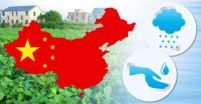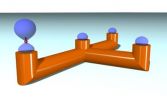(Press-News.org) PRINCETON, N.J.—China's rapid socioeconomic growth continues to tax national water resources – especially in the agricultural sector – due to increasing demands for food. And, because of the country's climate and geography, irrigation is now widespread, burdening rivers and groundwater supplies.
One solution to these growing problems, however, might be to reorganize the country's crop production and trade, especially in agricultural provinces such as Inner Mongolia, Heilongjiang and Hebei, according to new report issued by Princeton University's Woodrow Wilson School of Public and International Affairs and School of Engineering and Applied Science and scientists in China and Japan.
The researchers report in the journal Proceedings of the National Academy of Sciences that reducing agricultural production in these provinces and importing food commodities from other provinces or nations instead could help China conserve more water. These provinces all use large volumes of water to produce crops that are later exported to wetter regions. If balanced with more water-efficient irrigation systems locally, restructuring these regions could reduce national water use while avoiding an excessive geographically centralized agricultural production.
"Our analysis provides a framework for understanding how such policies would benefit China's water use in the future," said study co-author Denise Mauzerall, professor of environmental engineering and international affairs. In particular, corn production and trade at the domestic level might be an area to target as changes could significantly reduce national water use for irrigation."
"Overall, China may want to consider a targeted investment in agricultural research and development," said lead author Carole Dalin, a Princeton University Ph.D. student studying environmental engineering.
Of China's industries, agriculture is the most water-intensive in terms of production and covers most of the country's northern provinces. Crops like corn, rice and wheat thrive best in these drier regions, but rainfall is limited, and stores of underground water are diminishing. To fulfill high production demands, water is drawn from underground reservoirs (aquifers) in the northern provinces and used for irrigation more rapidly than it is replenished.
Water used during crop production is referred to as "virtual water." Through food trade, these water resources are transferred across borders in what's called a "virtual water trade." The researchers found that, in China, these transfers mostly occur from dry agricultural areas to wetter provinces. This situation places strain upon China's water reserves and will only intensify as China's economy and consumption of water-intensive food continues to boom. While growing crops in the wetter regions would be more water efficient, land in those places is either urban or industrial or difficult geographically (mountainous terrain, etc.), the researchers report.
"The need for China to include 'virtual water' in its national policy has been pointed out. Our provincial-scale domestic analysis of the country's virtual water trade is key to guiding such policy planning," said Dalin, who is a former Princeton Environmental Institute Science, Technology and Environmental Policy fellow.
To this end, the research team – which also includes Ignacio Rodriguez-Iturbe, the James S. McDonnell Distinguished University Professor of Civil and Environmental Engineering, and co-authors from China and Japan – combined a hydrological model with domestic and international trade simulations to determine the efficiency of China's food trade in terms of water use as well as the role of foreign trade in this virtual water-trade system. In particular, the researchers sought to answer one question: Is there a way to reduce China's water use without decreasing national food security?
The researchers looked at domestic and international trade of corn, rice, soy and wheat, along with such livestock products as ruminant (animals like cattle, goats and sheep that subsist on plant matter), pork and poultry. These products accounted for 93 percent of China's domestic food supply in 2005, the last year with available data. The researchers combined this information with water use across provinces – from both rainfall and irrigation sources – and determined how much water was transferred between provinces through food trade.
To obtain estimates of these water transfers, the researchers analyzed how much food was traded between provinces and the water amount needed to produce each type of food. They determined the amount of water transferred in kilograms by multiplying the traded volume of a specific food item by the water used to produce a unit of this item (the item's "virtual water content") in the exporting province.
The researchers found that irrigation accounts for about 25 percent of water used to produce crops and for 16 percent of water used in meat production in China. However, those numbers skyrocket in Xinjiang, Ningxia and Inner Mongolia, where irrigation water is used predominantly for crop production (85 percent, 69 percent and 49 percent, respectively.) These numbers indicate that such provinces see little rainfall during the growing season and rely heavily on sometimes non-renewable water resources, such as groundwater.
"This shows us that water is being used faster than it is being replenished, which cannot go on indefinitely," Mauzerall said.
Finally, the researchers investigated whether Chinese food trade leads to global water savings. They found that domestic corn trade leads to significant losses of irrigation water resources (such as rivers, reservoirs and groundwater). However, the provinces of Hubei, Henan, Jiangsu and Anhui, produce wheat quite efficiently, and their exports lead to large national water savings for both rainfall and irrigation water.
"Our work highlights opportunities for addressing water scarcity in China by adjusting where water intensive crops are grown and how they are traded" said Mauzerall. "Policies which encourage such adjustments can help conserve water while maintaining China's food security."
INFORMATION:
Additional authors include Naota Hanasaki from the National Institute for Environmental Studies in Japan and Huanguang Qiu from Renmin University of China.
The paper, "Water resources transfers through Chinese interprovincial and foreign food trade," was published June 23 in the Early Edition of the Proceedings of the National Academy of Sciences.
The study was supported by a Science, Technology and Environmental Policy (STEP) Fellowship, the Hack Graduate Award from the Princeton Environmental Institute, and a Global Systemic Risk Fellowship from the Princeton Institute for International and Regional Studies. Additional funders include the National Natural Science foundation of China (71222302, 71073154), the Newton Fellowship, Princeton's School of Engineering and Applied Sciences, the Global Collaborative Networks Fund and the Council for International Teaching and Research.
For more WWS Research Briefs, visit http://wws.princeton.edu/faculty-research/research-briefs.
Reorganization of crop production and trade could save China's water supply
2014-06-25
ELSE PRESS RELEASES FROM THIS DATE:
Collaborative learning -- for robots
2014-06-25
Machine learning, in which computers learn new skills by looking for patterns in training data, is the basis of most recent advances in artificial intelligence, from voice-recognition systems to self-parking cars. It's also the technique that autonomous robots typically use to build models of their environments.
That type of model-building gets complicated, however, in cases in which clusters of robots work as teams. The robots may have gathered information that, collectively, would produce a good model but which, individually, is almost useless. If constraints on power, ...
Are fish near extinction?
2014-06-25
"An end to seafood by 2050?" "Fish to disappear by 2050?" These sensational media headlines were the result of a 2010 report by the United Nations Environment Program, declaring that over-fishing and pollution had nearly emptied the world's fish stocks. That scarcity portends disaster for over a billion people around the world who are dependent on fish for their main source of protein.
Now, a new study by Dr. Roi Holzman and Victor China of the Department of Zoology at Tel Aviv University's George S. Wise Faculty of Life Sciences has uncovered the reason why 90% of fish ...
Fifty percent of quality improvement studies fail to change medical practices
2014-06-25
Over the last two decades, nearly half of all initiatives that review and provide feedback to clinicians on healthcare practices show little to no impact on quality of care, according to a new study by Women's College Hospital's Dr. Noah Ivers.
The study, published in the Journal of General Internal Medicine, found only 28 per cent of all studies showed an improvement of at least 10 per cent in quality of care over a 25-year period.
"Research shows there is a gap between recommended practices and the care patients actually receive," said Dr. Noah Ivers, a family physician ...
Fracking flowback could pollute groundwater with heavy metals
2014-06-25
VIDEO:
This video visualizes the effects of hydrofracking flowback fluid on colloid mobilization in unsaturated sand. Included are the injection of the colloids into the sand column at the beginning of...
Click here for more information.
ITHACA, N.Y. – The chemical makeup of wastewater generated by "hydrofracking" could cause the release of tiny particles in soils that often strongly bind heavy metals and pollutants, exacerbating the environmental risks during accidental spills, ...
LSTM Researchers demonstrate adaptive potential of hybridization in mosquito species
2014-06-25
Researchers from LSTM have exploited a natural experiment created by insecticidal pressure to determine how the most important malaria vectors - A. gambiae s.s. and A. coluzzii – respond rapidly to environmental change.
Working with genome analysis specialists from the Wellcome Trust Sanger Institute and field entomologists in Ghana, LSTM researchers sequenced the genomes of individual wild mosquitoes of each species from southern Ghana. The results, published in Nature Communications, reveal that transfer of a major insecticide resistance mutation (kdr) resulted in replacement ...
World's first magnetic hose created
2014-06-25
The magnetic hose designed by the researchers consists of a ferromagnetic cylinder covered by a superconductor material, a surprisingly simple design given the complicated theoretical calculations and numerous lab tests it had to undergo. A 14-centimeter prototype was built, which transports the magnetic field from one extreme to the other with a efficiency of 400% in comparison to current methods used to transport these fields.
Even with the efficiency of the prototype, researchers theoretically demonstrated that the magnetic hose can be even more efficient if the ferromagnetic ...
New method increases targeted bone volume by 30 percent
2014-06-25
In an important development for the health of elderly people, University of Liverpool researchers have developed a new method to target bone growth.
As people age their bones lose density and, especially in women after the menopause, become more brittle. The new method developed by researchers from the University's Institute of Ageing and Chronic Disease offers the possibility of more effective treatment than currently available.
Professor Jonathan Jarvis of Liverpool John Moores University designed miniature muscle pacemakers that were used in the University of Liverpool ...
Peer problem solving leads to operational efficiency
2014-06-25
Chestnut Hill, MA (June 25, 2014) - Strength in numbers may not just be a truism for those seeking moral and emotional support, but it also may be an avenue for those seeking customer support. New research shows peer-to-peer problem solving can lessen the need for firms to actually have to contact their supplier for a traditional customer support service call.
"This has never been shown before, this notion that people who have full-time day jobs handling support for their companies also take time to answer other people's questions, thereby significantly reducing their ...
Deep brain stimulation improves non motor symptoms in Parkinson's disease
2014-06-25
Amsterdam, NL, 25 June 2014 – Deep brain stimulation (DBS) has become a well-recognized non-pharmacologic treatment that improves motor symptoms of patients with early and advanced Parkinson's disease. Evidence now indicates that DBS can decrease the number and severity of non motor symptoms of patients with Parkinson's disease (PD) as well, according to a review published in the Journal of Parkinson's Disease.
"Non motor features are common in PD patients, occur across all disease stages, and while well described, are still under-recognized when considering their huge ...
Reproduction later in life is a marker for longevity in women
2014-06-25
(Boston)--Women who are able to naturally have children later in life tend to live longer and the genetic variants that allow them to do so might also facilitate exceptionally long life spans.
A Boston University School of Medicine (BUSM) study published in Menopause: The Journal of the North American Menopause Society, says women who are able to have children after the age of 33 have a greater chance of living longer than women who had their last child before the age of 30.
"Of course this does not mean women should wait to have children at older ages in order to ...


